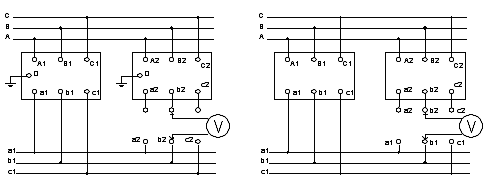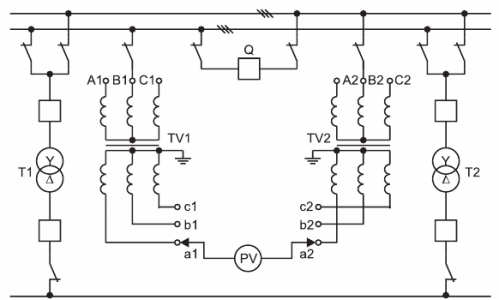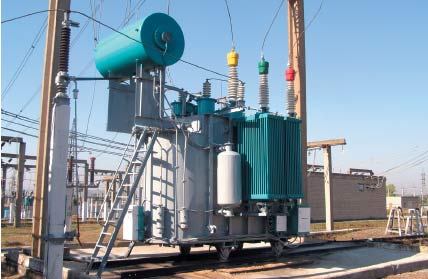Phasing of transformers for parallel operation
The phasing of the transformers is done to allow them to operate in parallel.
Phasing is called checking the phase coincidence of the voltages of the same name of the included transformer and the network or another working transformer. The check is reduced to finding pairs of terminals between which the voltage is zero. For windings up to 0.4 kV, the check is carried out with a voltmeter, up to 10 kV - with voltage indicators, above 10 kV - with the help of voltage measuring transformers.
Phase devices for transformers with earthed neutrals must be rated for two-line voltage. At voltages up to 10 kV, two voltage indicators are used, one of which instead of a capacitor and a neon lamp has 3-4 MΩ resistors at voltages up to 6 kV and 5-7 MΩ at 10 kV. The arrow clamps are connected with a flexible wire with reinforced insulation.
Conditions for parallel operation of transformers:
1. — the groups of connections of the windings of the transformer must be the same;
2. — equality of the transformation ratios of the line voltages at idle speed;
3.— equality of short-circuit voltages. Transformer phasing is checking the phase matching of the secondary voltages of two transformers connected in parallel.
How to phase transformers
 As a rule, phasing is done at the lowest voltage of the transformers. On windings with a voltage of up to 1000 V, phasing is carried out with a voltmeter for the corresponding voltage.
As a rule, phasing is done at the lowest voltage of the transformers. On windings with a voltage of up to 1000 V, phasing is carried out with a voltmeter for the corresponding voltage.
In order to obtain a closed electrical circuit when making measurements, the phase windings must first be connected at one point; for earthed neutral windings, this point is the connection of neutrals through earth.
For windings with an isolated neutral, re-phasing connect any two terminals of the phasing windings.
When phasing transformers with grounded neutrals, see Figure a — measure the voltage between terminal a1 and three terminals a2, B2, c2, then between terminal B1 and the same three terminals, and finally between c1 and all the same three terminals.

Phase circuits of transformers for connecting them to parallel operation
When the phase transformers without grounded neutrals, see figure b, first put a jumper between terminals a2 — a1 and measure the voltage between terminals b2 — b1 and c2 — c1, then put a jumper between terminals b2 — b1 and measure the voltage between terminals a2 — a1 and c2 — c1 and finally put a jumper between the terminals c2 — c1 and measure the voltage between the terminals a2 — a1 and b2 — b1.
For parallel operation of transformers, these terminals are connected between which there is no voltage.
 Trunks of phase power transformers (T1 and T2) at a voltage above 1 kV using voltage transformers (TV1 and TV2), the switch bus Q is open.
Trunks of phase power transformers (T1 and T2) at a voltage above 1 kV using voltage transformers (TV1 and TV2), the switch bus Q is open.
Transformers with the same connection groups are connected for parallel operation.In some cases, one group can be reduced to another by simple connections. So, the possibility of parallel operation of groups 0, 4, 8; 6, 10, 2; 11,3,7; 5, 9, 1, differing by 4 hours (120 electrical degrees), is provided by circular phase reversal.
Transformers of groups 0,4 and 8 can work in parallel with transformers of groups 6, 10 and 2 (shift of 180 degrees El.), if the beginning and end of the primary or secondary winding of one of the transformers is reversed.
Parallel operation of some odd groups can be ensured by crossing two phases at the highest and lowest voltage. At the same time, it is practically impossible to carry out parallel operation of even and odd groups of transformers. 
